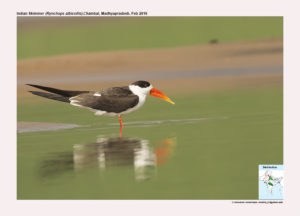Skimmer

Indian Skimmer Rynchops albicollis
Etymology:
- Rynchops : Greek word rhunkhos- bill; kopto– to cut off { Upper bill seems to be cut off}
- Albicollis : Latin word Albi – white ; Collis – Collar { White collared}
Vernacular Names: Hindi:Panchira, Pun: Pancheera, Guj: Jal-hal, Mar: Panchiri
Distribution in India: Resident of North and Central India.
Description: Size of 38–43 cm; wingspan of 102–114 cm; culmen of 58–75 mm. It is black above and white below, with broad white forehead, and comparatively shorter legs, and red and broad white trailing edge to secondaries and inner primaries visible in flight. Its most striking feature is long yellow-tipped red bill, with much longer lower mandible. The non-breeding adult has somewhat duller, browner upperparts, with mottled hindneck and rump. The female is similar to male, but is smaller. The juvenile is similar to non-breeding adult, but more browner and more heavily mottled above, with buff scaling, white-fringed tertials and primaries, and much shorter, duller bill.The juvenile is similar to non-breeding adult, but generally browner and more heavily mottled above, with buff scaling, white-fringed tertials and primaries, and much shorter, duller bill.
Habitat: It is found in rivers, particularly along calm stretches with sandbars, inshore coastal waters and freshwater tanks.
Food habits: It eats fish, insect larvae and shrimps. It is crepuscular and nocturnal, as well as diurnal, sometimes foraging on moonlit nights; such behaviour may be influenced by weather, like strong summer winds that prevent daytime feeding, or by prey activity. The food is caught exclusively by skimming the water in flight with mouth open and lower mandible submerged; prey items touched by mandible are grasped while head doubles back under body. The prey is swallowed in flight or after landing.
Breeding habits: They breed in Feb to Jun, with local variations dictated by water levels and colonies lying relatively synchronously. They are monogamous and colonial often with Terns, and Pratincoles. They nest on sandbanks or islands in larger rivers during season of low water. The nest is an unlined scrape in sand. They lay a clutch of 2–3 eggs. The incubation period is 21–24 days. Incubation is done by both sexes but mainly by female. Predators on eggs and young include Pallas’s Fish-eagle, crows, kites and jackals, but goats and cattle may trample eggs and chicks, and domestic dogs eat nestlings.